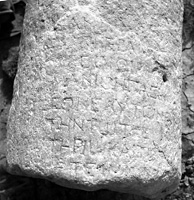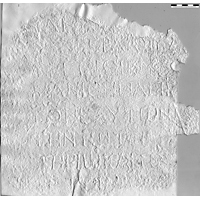 MAMA XI 294 (Konya)
MAMA XI 294 (Konya) 
Honorific column for Manius son of Pasikrates
- Type of monument:
- Honorific column.
- Location:
- Tatlıkuyu (Akbaş) (Konya): by the mosque.
- Description:
- Coarse greyish marble column, broken below.
- Dimensions:
- Ht. 0.80+; Diameter 0.40; letters 0.020-0.027.
- Record:
- Squeeze; MB notebook copy; photograph (1957/47).
- Publication:
- Sterrett 1888a: 226, no. 253; [Laminger-Pascher 1984: 103-4, no. 168; SEG 34, 1400].
- Date:
- Roman imperial period.
ΚΑΝΑΙΟ[- - -]
ε̣ω̣ν γεραιοὶ κα[ὶ πάν]-
τ̣ες οἱ οἰκή[τορες]
Μάνιον Πασικ[ράτους]
5τὸν ἑαυτῶν εὐ[εργέ]-
την τῷ τε̣ ει̣[. . 4-5 . .]
τηρίῳ καὶ τῷ [. . 4-5 . .]
ἐτείμησαν [ vac. (?)]
Line 3: omitted by Sterrett.
...the elders and all the inhabitants honoured Manius son of Pasik[rates], their benefactor, with the [...] and the [...].





This inscription was seen in 1884 by Sterrett at Zencirli hanı (see MAMA XI 297 [1957/18]). By 1957, the inscription was at the mosque in Tatlıkuyu (now Akbaş), around 10km north-east of Zencirli hanı. The condition of the stone had deteriorated slightly in the intervening period; underlined letters, seen by Sterrett, are not visible on Ballance’s squeeze or photograph. Line 3 was accidentally omitted by Sterrett in his transcription.
The monument is an honorific inscription set up by the ‘elders and all the inhabitants’ of a village on the territory of Ikonion; the village ethnic (in the genitive plural) may have been recorded in lines 1-2 (Laminger-Pascher 1984: 103). For the existence of a formal corporate body of γεραιοί (sometimes, but not always, designated as a γερουσία) in many Anatolian village communities in the Roman imperial period, see Schuler 1998: 225-31; their role seems to have been comparable to that of the civic βουλή. I know of no other instance in which the γεραιοί are distinguished from the other οἰκήτορες (‘inhabitants’) of a village, but compare TAM V 3, 1415 (territory of Philadelpheia): ἐν Καστωλλῷ κώμῃ Φιλαδελφέων γενομένης ἐκκλησίας ὑπὸ τῆς γερουσίας καὶ τῶν λοιπῶν κωμητῶν πάντων, ‘when an assembly was held in the village of Kastollos, on Philadelpheian territory, by the gerousia and all the other villagers...’.
The honorand, Manius, carries a Latin name which was relatively common in Lykaonia (I.Konya 234; MAMA VII 47; SEG 6, 355). His father’s name, Pasikrates, is also a common one in the region (MAMA XI 323 (1956/174), 320 (1956/176), MAMA VIII 273-5 [Perta]; Hall 1968: 81, no. 31, and 86, no. 45; Drew-Bear, Lubotsky and Üyümez 2008: 113-5, no. 3 [Greek/Neo-Phrygian bilingual, Polybotos]). It is possible that the honorand is a relative of Neikias, son of Pasikrates, grandson of Manius, native of the village of Komitanassos, who set up a dedication to Apollo at Ortakuyu, in the steppe south of Lake Tatta MAMA XI 365 [1956/191]).
I am unable to offer any convincing proposals as to the honours which Manius may have received in lines 7-8; the suggestions of Laminger-Pascher 1984: 104 τῷ τ[αφ]εί[ῳ τιμη]τηρίῳ καὶ τῷ [τίτλῳ] are unparalleled and incompatible with the traces on the stone. In lines 7-8, we could restore τῷ ἐγ̣[κοιμη]τηρίῳ (Manius honoured with burial at the village’s expense); at the end of line 8, given the columnar form of the monument, we could restore καὶ τῷ [κίονι]. For the use of the term κίων for funerary monuments of this kind, cf. I.Konya 138.